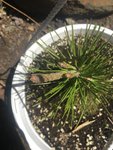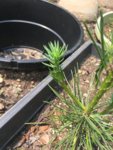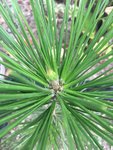You are using an out of date browser. It may not display this or other websites correctly.
You should upgrade or use an alternative browser.
You should upgrade or use an alternative browser.
Anyone familiar with this pine species
- Thread starter Bonds Guy
- Start date
Wires_Guy_wires
Imperial Masterpiece
It looks like this one skipped the budding phase and went straight to juvenile foliage in a second flush.
Makes me think it's JBP. The amount of branches it's growing also hint towards JBP or maybe Japanese red pine.
However, I found that even mugo pines continuously flush with juvenile foliage if you stress them enough. So it could be any two needle pine for that matter.
Makes me think it's JBP. The amount of branches it's growing also hint towards JBP or maybe Japanese red pine.
However, I found that even mugo pines continuously flush with juvenile foliage if you stress them enough. So it could be any two needle pine for that matter.
DirkvanDreven
Shohin
If the needles are sharp and rigid, it is probably JBP
Potawatomi13
Imperial Masterpiece
If the needles are sharp and rigid, it is probably JBP
Bosnian pine more sharp/stiff
Leo in N E Illinois
The Professor
- Messages
- 11,341
- Reaction score
- 23,294
- USDA Zone
- 5b
I have sprouted a number of pines from seed. I have had JWP and Pinus bungeana retain juvenile foliage for 3 summers before converting to the needles in bundles of mature foliage. Your seedlings are young and small. Get them into full sun and keep them growing this year. By next summer they should settle down and begin to look like what ever they really are.
If your seed source was a reputable dealer like Sheffield's, or Schumacker, there is no reason to doubt their labelling. Seed from internet re-sellers could be just about anything.
Quality sourced seed saves a lot of headaches if the outcome is important.
If your seed source was a reputable dealer like Sheffield's, or Schumacker, there is no reason to doubt their labelling. Seed from internet re-sellers could be just about anything.
Quality sourced seed saves a lot of headaches if the outcome is important.
Bonds Guy
Mame
I bought the seeds from a random chinese ebay seller. I thought since they only cost $0.75 its not a huge risk and bonsai orginated in china so that makes them somewhat trustworthy lol.I have sprouted a number of pines from seed. I have had JWP and Pinus bungeana retain juvenile foliage for 3 summers before converting to the needles in bundles of mature foliage. Your seedlings are young and small. Get them into full sun and keep them growing this year. By next summer they should settle down and begin to look like what ever they really are.
If your seed source was a reputable dealer like Sheffield's, or Schumacker, there is no reason to doubt their labelling. Seed from internet re-sellers could be just about anything.
Quality sourced seed saves a lot of headaches if the outcome is important.
Bonds Guy
Mame
Leo in N E Illinois
The Professor
- Messages
- 11,341
- Reaction score
- 23,294
- USDA Zone
- 5b
Needles in bundles of 2. If you treat it like a single flush 2 needle pine, you won't kill it. Even the double flush pines like JBP, will not be harmed if treated like a single flush pine.
This is proof you got $0.75 worth of seed, definitely not Japanese white pine. The same quantity of JWP seed from a reputable company with brick and mortar headquarters and a real address would have cost $5, and every seedling would have been JWP, you would not have had to ask for identification.
It is fun to have the occasional mystery. But until one of your seedlings matures to produce a pine cone and pollen cones, yo will not be able to to say with certainty that these are one species or another.
Most likely the Chinese race of Japanese black pine. But they could be Japanese red pine or one of the other 2 needle pines found in the Chinese landscape. They have at least 6 or more 2 needle pine species native to China, in addition, introduced species like Pinus sylvestris are possible. Good luck sorting it out.
This is proof you got $0.75 worth of seed, definitely not Japanese white pine. The same quantity of JWP seed from a reputable company with brick and mortar headquarters and a real address would have cost $5, and every seedling would have been JWP, you would not have had to ask for identification.
It is fun to have the occasional mystery. But until one of your seedlings matures to produce a pine cone and pollen cones, yo will not be able to to say with certainty that these are one species or another.
Most likely the Chinese race of Japanese black pine. But they could be Japanese red pine or one of the other 2 needle pines found in the Chinese landscape. They have at least 6 or more 2 needle pine species native to China, in addition, introduced species like Pinus sylvestris are possible. Good luck sorting it out.
Bonsai Nut
Nuttier than your average Nut
So it could be any two needle pine for that matter.
The only thing I would add is that it is a long-needled two-needle pine. Some other two-needle pines (like mugos) have much shorter needles.
I am not a pine ID expert by any means. It looks exactly like my JBP seedlings... but aside from that I can't provide any help
Bonds Guy
Mame
Hey guys so here’s another attempt to identify this species of pine. I noticed a few 3 needle bundles and the candles are covered in this web-like substance


Fyi this pine is the one in the background of the 1st post. Mistakes were made on the original one so its in a recovery area but it didn’t have the web-like wrapping on the candles and I’m not entirely sure about the 3 needle bundle


Fyi this pine is the one in the background of the 1st post. Mistakes were made on the original one so its in a recovery area but it didn’t have the web-like wrapping on the candles and I’m not entirely sure about the 3 needle bundle
DirkvanDreven
Shohin
Probably JBP. Bundles of 3 needles happens on my JBP also.Looks like JBP to me
Leo in N E Illinois
The Professor
- Messages
- 11,341
- Reaction score
- 23,294
- USDA Zone
- 5b
To sort out what you have, I would have to look at lists of pine species with 2 or 3 needles. The link at the bottom is Wikipedia, which is the most handy and fairly useful site. There are others that have "higher botanical authority" but it is "good enough". So you are welcome to read through yourself.
I still think it is one of 6 or 7 Chinese native species of pines, or it is Pinus radiata, which is planted very widely around the subtropical and tropical world for pulp plantation forestry. So you have 8 or so species of pines to take a serious look at and decide for yourself what you have.
Those "cob webs" are cilia, or indumentum, hairs, that serve to protect young and tender buds from excess sun and possibly insects until the buds are better developed. Sometimes the presence or absence of these hairs is diagnostic for determining species. Have fun with your digging.
 en.wikipedia.org
en.wikipedia.org
I still think it is one of 6 or 7 Chinese native species of pines, or it is Pinus radiata, which is planted very widely around the subtropical and tropical world for pulp plantation forestry. So you have 8 or so species of pines to take a serious look at and decide for yourself what you have.
Those "cob webs" are cilia, or indumentum, hairs, that serve to protect young and tender buds from excess sun and possibly insects until the buds are better developed. Sometimes the presence or absence of these hairs is diagnostic for determining species. Have fun with your digging.
List of Pinus species - Wikipedia
Vance Wood
Lord Mugo
I have never seen a Miugo flush with juvenile foliage, continuously when stressed and I have stress a lot of them.It looks like this one skipped the budding phase and went straight to juvenile foliage in a second flush.
Makes me think it's JBP. The amount of branches it's growing also hint towards JBP or maybe Japanese red pine.
However, I found that even mugo pines continuously flush with juvenile foliage if you stress them enough. So it could be any two needle pine for that matter.
Wires_Guy_wires
Imperial Masterpiece
I think you're not cutting off enough to get them to revert. Sarcasm: It takes some practice, but if you reduce the canopy to 15% of the original and work the roots at the same time, I would be surprised if they don't revert.I have never seen a Miugo flush with juvenile foliage, continuously when stressed and I have stress a lot of them.
Of course that's a bad practice, you know this, I know this now too. I knew it before I started torturing that poor tree, but I wanted to see for myself.
A year later, that same mugo has stopped producing juvenile foliage, but it's still flushing continuously. It's the one I was discussing on the mugo train. You asked for a picture, it's on that same page at post number #3422 if memory serves me right.
Vance Wood
Lord Mugo
If you cut a Mugo back that far it would be jaw dropping surprising if you did not kill the tree. I have found the reaction you have described to be the last effort a tree will put out before dying. This I have seen.
Similar threads
- Replies
- 0
- Views
- 443
- Replies
- 18
- Views
- 9K
- Replies
- 93
- Views
- 14K
- Replies
- 31
- Views
- 7K





